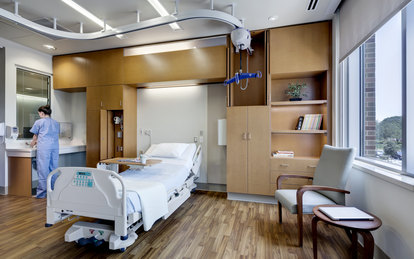Relational Sustainability: Environments for Long-term Critical Care Patients

In recent years, a new type of critical care patient has emerged who requires both intense care and long-term care in the same facility. Patients undergoing bone marrow transplant, using spinal cord services, and with traumatic brain injury represent a relatively new patient type, requiring both intense care and long-term care in the same facility. As medical advances allow these patients the opportunity to recover from their critical illnesses or injuries, designers and caregivers must give increased attention to the long-term critical care environment. Designing for this type of care requires an understanding of new technologies and the potential for the built environment to address the wide range of physical, sensory, and psychological issues long-term inpatients face.
Recent work by SmithGroupJJR has provided valuable insights into the ways in which lighting, patient room and unit layouts, spatial volumes, and other design elements can contribute to the recovery of patients who must spend weeks or months in a critical care environment. This knowledge was gained through an approach that allows design professionals to immerse themselves in a healthcare institution’s values, culture, and work processes. By mapping both operational flow and patients’ experiences, project teams can develop design solutions that sustain the well-being
of higher-acuity patients and their family members and caregivers.
The designer’s job is to listen to the people who will use the space being created in order to make the most efficient, most comfortable environment for them. This is especially true when dealing with a new type of space, such as a long-term critical care unit. New patient types require a rethinking of optimal operations and facilities to optimize care for these patients. If the project team is willing to suspend belief in the status quo and approach design with minds prepared to recognize new opportunities, novel solutions arise. For this to happen, all stakeholders must have a deep understanding of patient, family, and caregiver needs, as well as an awareness of the potential for the built environment to address these needs. When architects and planners become immersed in the culture of a healthcare organization and members of the organization are open to creating settings that may be without precedent, together they can develop design solutions that sustain patients and their family members and caregivers.
Mammen, J., & Costello, B. (2014). Relational Sustainability: Environments for Long-term Critical Care Patients. Critical Care Nursing Quarterly, 37(1), 53-66. Please click here to access the full article.